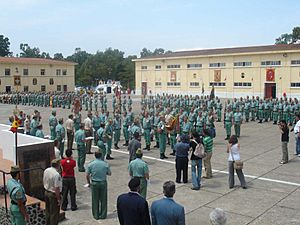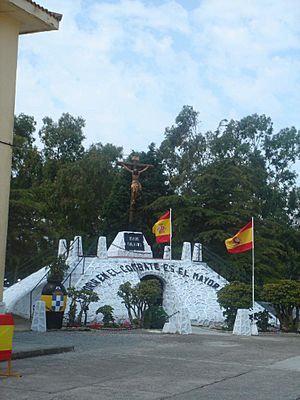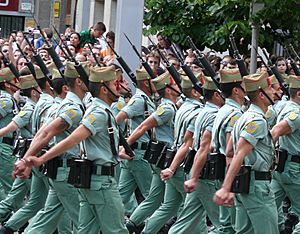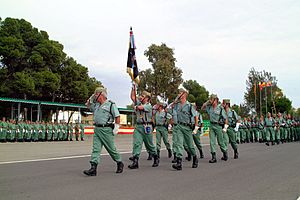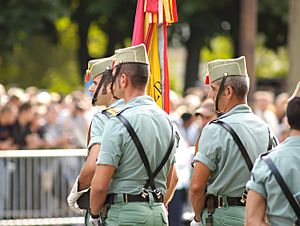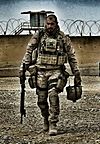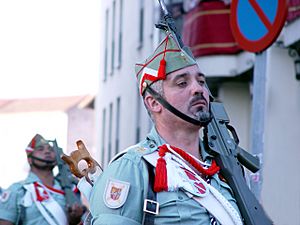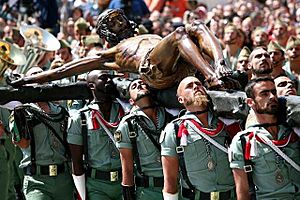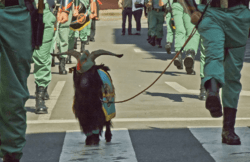Spanish Legion facts for kids
Quick facts for kids Spanish Legion |
|
|---|---|
| Legión Española | |
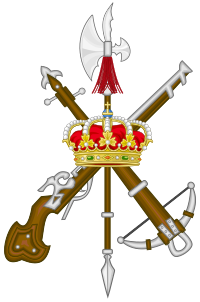
Badge of the Spanish Legion
|
|
| Founded | 28 January 1920 |
| Country | |
| Allegiance | "God, King, Spain" |
| Branch | |
| Type | Light infantry, shock troops |
| Size | 8,000 |
| Garrison/HQ |
|
| Nickname(s) | Novios de la muerte ("Grooms of Death") |
| Motto(s) | ¡Legionarios a luchar! ¡Legionarios a morir! ("Legionnaires, to fight! Legionnaires, to die!") |
| March |
|
| Anniversaries | 20 September |
| Engagements |
|
| Commanders | |
| Notable commanders |
José Millán-Astray Francisco Franco |
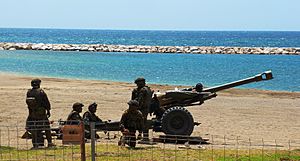
The Spanish Legion (Legión Española, La Legión) is a special military unit within the Spanish Army. It is also known informally as the Tercio or the Tercios. For centuries, Spain used foreign soldiers in its army. However, the modern Spanish Legion was created in the 20th century. It was formed in January 1920 to be part of Spain's Army of Africa.
The unit was first called the Tercio de Extranjeros ("Tercio of Foreigners"). It was similar to the French Foreign Legion. The Legion began fighting in the Rif War from 1921 to 1926. Even though it was called the "Foreigners' Tercio," most of its members were Spaniards. Over time, its name changed to Tercio de Marruecos and then to the "Spanish Legion."
The Legion played a big part in the Spanish Civil War on the Nationalist side. After that, the modern Legion has served in many international missions. These include the Yugoslav Wars, Afghanistan, Iraq, and Operation Libre Hidalgo UNIFIL.
Contents
History of the Spanish Legion
The Spanish Legion was officially created by King Alfonso XIII on January 28, 1920. The Minister of War, José Villalba Riquelme, announced its formation. In the 1920s, most of the Legion's soldiers were from Spain. Some foreign members came from places like Cuba.
Before the Modern Legion
There was an earlier "Spanish Foreign Legion" before the modern one started in 1920. In 1835, the French government sent its French Foreign Legion to Spain. They came to support Queen Isabella during the First Carlist War. About 4,000 French Legionnaires arrived in Spain. This unit was the first Spanish Legion until it was disbanded in 1838.
The Name "Spanish Legion"
The Spanish Legion was designed like the French Foreign Legion. Its main goal was to provide professional soldiers for Spain's colonial wars in North Africa. These professional troops were more effective than soldiers who were forced to join the army. The first commander, Lieutenant Colonel José Millán-Astray Terreros, called his unit "La Legión" from the beginning. This name became official in 1937.
At first, the Tercio de Extranjeros had a few soldiers from different countries. These included China, Japan, Malta, Russia, and the United States. However, most of its members were Spaniards who wanted to fight outside of Europe.
The word Tercio means "a third" in Spanish. It is an old Spanish military term. It is like a "regiment" today. The name was chosen to remind people of Spain's powerful army in the 16th century. Back then, Spanish infantry units called tercios were very famous.
In 1925, the unit's name changed to Tercio de Marruecos ("Tercio of Morocco"). This was shortened to "The Tercio." In 1937, during the Spanish Civil War, it was renamed La Legión. This is the name it still uses today.
Early Battles and Campaigns
The Spanish Legion's first big mission was in Spanish North Africa. In 1920, Spain was fighting a rebellion in Spanish Morocco. The rebellion was led by a strong leader named Abd el-Krim. On September 2, 1920, King Alfonso XIII gave command of the new regiment to Lieutenant Colonel José Millán-Astray. Millán-Astray was a skilled soldier with a unique personality. His style helped create the special spirit of the Legion.
The first soldier joined the new Legion on September 20, 1920. This date is now celebrated every year. The first regiment had a headquarters and three battalions. These battalions were called Banderas, which means "banners." Each Bandera had a headquarters company, two rifle companies, and a machine gun company. The Legion's first base was in Ceuta. During the Spanish Civil War, the Legion grew to 18 Banderas.
Francisco Franco was one of the Legion's early leaders. He was the unit's second-in-command and also led the 1st Legion Bandera. The Legion fought in Morocco in the Rif War until 1926. Along with the Regulares (Moorish colonial troops), the Legion formed the Spanish Army of Africa. In 1934, units from the Legion and the Regulares were sent to Spain. They helped the government stop a workers' revolt in Asturias.
During the Spanish Civil War, the Army of Africa, led by Lieutenant Colonel Juan Yagüe, was very important for the Nationalist side. The Legion and Regulares were very professional. This gave Franco's rebel troops a big advantage over the less trained Republican forces. After the Nationalists won in 1939, the Legion became smaller. It returned to its bases in Spanish Morocco. Later, the Legion got its current structure of four Tercios. The 4th Tercio was added in 1950:

 1st Tercio "Great Captain Gonzalo Fernandez de Cordoba"
1st Tercio "Great Captain Gonzalo Fernandez de Cordoba" 
 2nd Tercio "Fernando Alvarez de Toledo, Duke of Alba"
2nd Tercio "Fernando Alvarez de Toledo, Duke of Alba" 
 3rd Tercio "Don Juan de Austria"
3rd Tercio "Don Juan de Austria" 
 4th Tercio "Alexander Farnese, Duke of Parma"
4th Tercio "Alexander Farnese, Duke of Parma"
When Morocco became independent in 1956, the Legion stayed in the Spanish areas of North Africa. The Legion fought against Arab groups in the Ifni War from 1957 to 1958. In 1970, Legion units were involved in a confrontation with demonstrators in El Aaiun, Spanish Sahara. This event, known as the Zemla Intifada, influenced the local anti-colonial movement.
Throughout its history, most of the Legion's members have been Spaniards. Foreigners usually made up 25 percent or less of the force. In the 1920s, most foreigners in the Legion were Spanish-speaking Latin Americans.
The Modern Legion Today
In the 2000s, Spain stopped requiring young people to join the military. The Spanish Legion then began accepting foreigners again. Many Spanish-speaking men and women, mostly from Central and South American countries, joined.
To join the Spanish Legion today, you need to meet these requirements:
- Be a Spanish citizen, or a citizen from a former Spanish territory with a valid Spanish residence permit.
- Have a good legal record.
- Be at least 18 years old but not older than 29 when joining.
- Pass psychological, physical, and medical tests.
In recent years, the Spanish Legion has served in Bosnia as part of the SFOR peacekeeping force. They also took part in the Iraq War, working with soldiers from El Salvador in Najaf. In 2005, the Legion was sent to Afghanistan as part of the NATO-led International Stabilisation Force (ISAF). In 2006, a Legion unit went to Southern Lebanon for a United Nations mission called UNIFIL.
Current Role and Location
Today, the Spanish Legion mainly takes part in NATO peacekeeping missions. It has about 5,000 soldiers. They are organized into a Brigade with two Tercios (regiments). These are based in Ronda, Málaga, and Viator, Almería. Two other independent tercios are stationed in the Spanish cities of Ceuta and Melilla in North Africa. The Spanish General Staff directly controls the Legion.
Every year, a company of Legionnaires from one of the Tercios returns to Málaga. They march in the Holy Week procession with the Christ of the Good Death. This is a statue of Christ that the Legion adopted as its patron in the 1920s. The Legion also has its own group in Málaga, where many veterans are members. Legion units also participate in other Holy Week events across Spain.
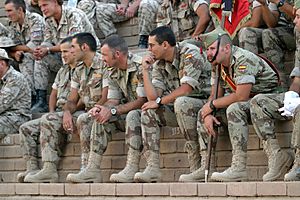
Units of the Modern Spanish Legion
The active units of the Spanish Legion are:
- II Spanish Legion Brigade "Rey Alfonso XIII" in Viator
- 2nd Spanish Legion Headquarters Bandera
- 2nd Spanish Legion Light Armored Cavalry Group "Reyes Católicos"
- 3rd Spanish Legion Tercio "Don Juan de Austria"
- VII Spanish Legion Bandera "Valenzuela"
- VIII Spanish Legion Bandera "Colón"
- 4th Spanish Legion Tercio "Alejandro Farnesio"
- X Spanish Legion Bandera "Millán Astray"
- 2nd Spanish Legion Field Artillery Group
- 2nd Spanish Legion Engineer Battalion
- 2nd Spanish Legion Logistic Group
In other commands:
- 1st Spanish Legion Tercio "Gran Capitán"
- I Spanish Legion Bandera "España"
- 2nd Spanish Legion Tercio "Duque de Alba"
- IV Spanish Legion Bandera "Cristo de Lepanto"
Special Forces of the Spanish Legion
The Legion has a special operations unit. It was known as the Bandera de operaciones especiales de la legión (19th Legion Special Operations Battalion or BOEL). Members of this unit volunteer from other Legion Banderas. They receive special training in many areas. This includes diving, mountain warfare, demolitions, and parachute techniques. They also learn long-range scouting and counter-terrorism. Much of their training took place at Fort Bragg in the USA.
In 2002, the BOEL was renamed the 19th Special Operations Group "Maderal Oleaga" (GOE-XIX). It moved to Alicante and reported directly to Army Headquarters. In 2019-2020, the battalion returned to the Legion Command. It is now the Legion's contribution to Army Special Operations.
- 19th Special Operations Group "Maderal Oleaga"
Ranks in the Legion
The military ranks and promotion rules in the Spanish Legion are the same as for the rest of the Spanish Army. The only difference is that soldiers (OR-1) in the Legion are called "Caballeros Legionarios" (Legionary Gentlemen). Legionnaires see this title as a special honor. They earn it through tough training and tests.
Basic Training for Legionnaires
Basic training for the Legion lasts four months. It takes place in Cáceres or Cádiz. The training includes basic military skills, long forced marches, and a difficult obstacle course. After two months, recruits sign a 2 or 3-year contract. Once basic training is finished, the recruit joins one of the Tercios. There, they receive more training, which can last from 1 to 10 months depending on their assigned specialty. This process is similar to other units in the Spanish army.
Uniforms and Equipment
Legion Uniforms
Since its beginning, the Legion has been known for its simple uniforms. This was different from the colorful uniforms worn by other Spanish Army regiments. This simple style was part of the Legion's focus on being ready for constant action.
Today, the Legion uses the same camouflage uniforms for active service as the rest of the Spanish Army. However, they keep their unique sage-green tropical uniform for semi-formal events and parades. The most recognizable part of the Legion uniform is the khaki "gorrillo" cap or "chapiri." It has a red tassel and piping.
Unlike other military units, Legionnaires are allowed to have beards. They can also wear their uniforms open at the chest.
Legion Equipment
The Legion uses the same basic weapons as the rest of the Spanish Army. These include the G36-E rifle. They also use the AG36 grenade launcher, HK MG4 and MG3 machine guns, and the HK USP 9mm pistol.
For larger weapons, the Legion uses the M2 Browning machine gun and the SB LAG 40 automatic grenade launcher on their armored vehicles.
The Legion's artillery group uses L118 105mm Light Guns. They also use Italian wheeled tank destroyers called B1 Centauro.
The Legion uses various vehicles, including Land Rovers, Spanish-made BMR and VEC-M1 vehicles, VAMTAC trucks, and URO trucks. They also use foreign vehicles like the LMV and RG31.
The Spirit of the Legion
José Millán-Astray gave the Legion a special spirit and symbols. These were meant to remind people of Spain's Imperial and Christian history. For example, the Legion used the name tercio. This honored the 16th-century Spanish infantry units that were famous in Europe. The Legion's coat of arms shows weapons used by these old tercios: a musket, a halberd, and a crossbow.
Legion Traditions
The Legion has many unique customs and traditions:
- All members, no matter their rank, are called Caballero Legionario ("Legionary Gentleman"). If women join, they are called Dama Legionaria ("Legionary Lady").
- They follow a special "Mística Legionaria" (Legionary Spirit). This spirit is summarized in a twelve-point "Credo Legionario", or "Legionary Creed."
- Legionnaires call themselves Novios de la muerte ("bridegrooms of death"). This nickname is also the title of one of the Legion's official songs. The other song is La Canción del Legionario ("The Legionary's Song").
- If a Legionnaire is in trouble, they shout ¡A mí la Legión! ("To me the Legion!"). Anyone nearby is expected to help them, no matter what. Legionnaires are never supposed to leave a comrade behind in battle.
- The Legion's marching speed is very fast. It is 160-180 steps per minute, much faster than the usual 90 steps per minute for other Spanish military units.
- During the Holy Week processions in Málaga, Legionnaires carry the statue of the Christ of Good Death on their shoulders. This happens on Holy Thursday morning. They also join the procession through the streets of Málaga later that day.
- Under its founder, José Millán-Astray, the Legion's motto was ¡Viva la muerte! ("Long live death!"). This motto was used less after the death of Francisco Franco.
- The Legion has had several mascots over the years. These include monkeys, chickens, capercaillies, wild boars, barbary sheep, bears, and parrots. Today, the mascot is a goat. The goat often appears in parades and ceremonies. It wears a Legion cap and walks with a Legionnaire, leading the marching troops.
- While the Legion has mostly been an infantry (foot soldier) force, it has also had armored, artillery, and engineer units. In the 1920s, a group of mounted lanceros (lancers) was part of the Legion. In 1982, a mounted section was formed to carry traditional lances in Holy Week Processions in Málaga.
- The Military bands and Bugle bands of the Legion continue its musical traditions. The Legion's bugle bands are unique in the Spanish Armed Forces. They use plain bugles instead of valved bugles. They also use a small cornetín or piccolo bugle for calls and leading the band.
- In the past, the Legion marched past in the same way as other Spanish Armed Forces. Now, officers and color guards only give a hand salute and look right when marching past. When standing still and giving full salutes, they only use a hand salute.
Anthems and Marches
Slow March
El Novio de la Muerte (Bridegroom of Death) is the unofficial hymn and slow march of the Spanish Legion. It was written in 1921.
Quick Marches and Official Anthem
La Cancion del Legionario (The Legionnaire's Song) is the official quick march and anthem of the Legion. It was composed in 1920. The Legion's military bands play it at a fast 190 beats per minute, which is unique to them.
Before this, Le Madelon and Tercios Heroicos (Heroic Tercios) were the Legion's official march tunes.
Some Famous Legionnaires
Here are some Legionnaires who became well-known:
- Francisco Franco: A general and dictator of Spain from 1939 to 1975. He was a founding deputy commander of the Spanish Legion in 1920. He later commanded the Legion from 1923 to 1926.
- Prince Sixtus Henry of Bourbon-Parma: He joined as Enrique Aranjuez in 1965. He was a Carlist pretender (someone who claims a throne) to the Spanish throne.
- José Millán-Astray: The founder and first commander of the Spanish Legion. He served until 1923.
- Enrique San Francisco: An actor.
- José Manuel Lara Hernández
- Pedro Marangoni: A writer and pilot.
- Peter Kemp: A British secret agent and writer.
- Pino Rauti: An Italian politician.
See also
 In Spanish: Legión Española para niños
In Spanish: Legión Española para niños
- Army of Africa (Spain)
- FAMET
- Foreign legion
- Israeli Mahal program
- List of Spanish Legionnaires
- Regulares


